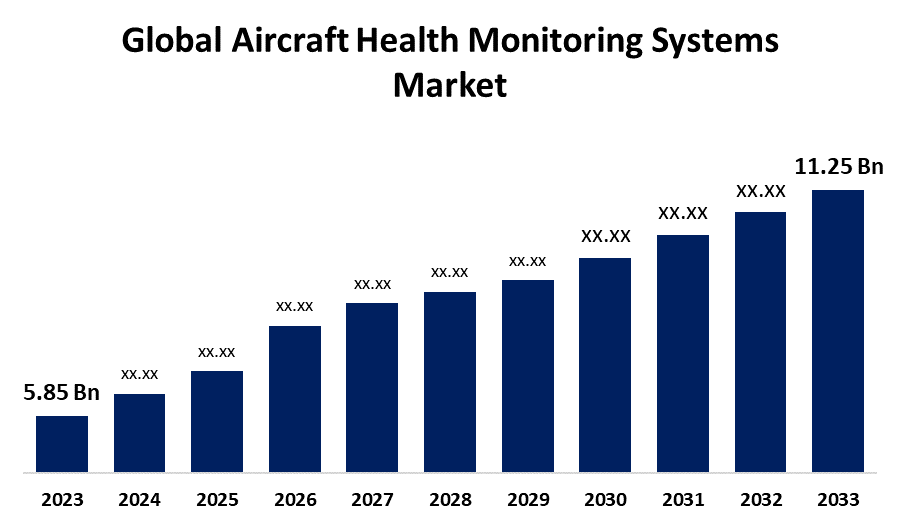Global Aircraft Health Monitoring Systems Market Size, Share, and COVID-19 Impact By Component (Hardware, Software, and Services), By Platform (Commercial Aviation, Business Aviation, and Military Aviation), By Installation Type (Onboard and On-ground), By Region (North America, Europe, Asia-Pacific, Latin America, Middle East, and Africa), Analysis and Forecast 2023 - 2033.
Industry: Aerospace & DefenseGlobal Aircraft Health Monitoring Systems Market Insights Forecasts to 2033
- The Global Aircraft Health Monitoring Systems Market Size was estimated at USD 5.85 Billion in 2023
- The Market Size is expected to Grow at a CAGR of around 6.76% from 2023 to 2033
- The Worldwide Aircraft Health Monitoring Systems Market Size is Expected to Reach USD 11.25 Billion by 2033
- Asia-Pacific is expected to Grow the fastest during the forecast period.

Get more details on this report -
The Global Aircraft Health Monitoring Systems Market Size was worth around USD 5.85 Billion in 2023 and is predicted to grow to around USD 11.25 Billion by 2033 with a compound annual growth rate (CAGR) of 6.76% between 2023 and 2033. The market is driven by the rising need for real-time health monitoring systems to improve the safety and efficiency of aircraft operations. Additionally, with aviation industries globally emphasizing cost reductions in operations and improved flight safety, integrating advanced health monitoring systems becomes a critical requirement.
Market Overview
The aircraft health monitoring systems market refers to onboard systems that gather and evaluate real-time information from engines, avionics, and structures. By catching anomalies and gaining foresight on required maintenance, AHMS enhances aircraft safety of flight, decreases downtime, and enables proactive aviation maintenance approaches to assist airlines with maximizing operational performance and lowering the cost of surprises. The aircraft health monitoring systems market offers a large number of opportunities with the technological advancements and growing relevance of real-time data analytics. The use of artificial intelligence and machine learning algorithms in health monitoring systems is a major opportunity, allowing for early detection of possible problems and minimizing the risk of unplanned maintenance. Moreover, the growing emphasis on sustainability and fuel efficiency offers an opportunity for health monitoring systems to maximize engine performance and minimize carbon emissions, meeting global environmental objectives and regulations. Additionally, several government programs are aimed at encouraging Aircraft Health Monitoring Systems (AHMS) and associated technologies, especially in India. These include the Ministry of Electronics and Information Technology (MeitY)'s "SwaYaan" initiative and the Indian Air Force's (IAF) invitation for industrial partnership for remote in-flight health monitoring. These programs are intended to improve safety, efficiency, and operational performance through enhanced monitoring and maintenance practices.
Report Coverage
This research report categorizes the aircraft health monitoring systems market based on various segments and regions, forecasts revenue growth, and analyzes trends in each submarket. The report analyzes the key growth drivers, opportunities, and challenges influencing the aircraft health monitoring systems Market. Recent market developments and competitive strategies such as expansion, type launch, development, partnership, merger, and acquisition have been included to draw the competitive landscape in the market. The report strategically identifies and profiles the key market players and analyzes their core competencies in each sub-segment of the aircraft health monitoring systems market.
Global Aircraft Health Monitoring Systems Market Report Coverage
| Report Coverage | Details |
|---|---|
| Base Year: | 2023 |
| Market Size in 2023 : | USD 5.85 Billion |
| Forecast Period: | 2023-2033 |
| Forecast Period CAGR 2023-2033 : | 6.76% |
| 2033 Value Projection: | USD 11.25 Billion |
| Historical Data for: | 2019-2022 |
| No. of Pages: | 200 |
| Tables, Charts & Figures: | 100 |
| Segments covered: | By Component (Hardware, Software, and Services), By Platform (Commercial Aviation, Business Aviation, and Military Aviation), By Installation Type (Onboard and On-ground), By Region (North America, Europe, Asia-Pacific, Latin America, Middle East, and Africa) |
| Companies covered:: | Rolls-Royce Holdings plc, Safran S.A., Meggitt PLC, Thales Group, Lufthansa Technik, Embraer S.A., Pratt & Whitney, BAE Systems, Northrop Grumman Corporation, SITAONAIR, Curtiss-Wright Corporation, FLYHT Aerospace Solutions Ltd., GE Aviation, AeroMechanical Services Ltd., and Others |
| Pitfalls & Challenges: | COVID-19 Impact, Challenges, Future, Growth, & Analysis |
Get more details on this report -
Driving Factors
The aircraft health monitoring systems market is driven by some major trends. The fast-rising growth of the market for aircraft health monitoring systems. Advances in sensor technologies, data analytics, and wireless connectivity are making it possible to provide more accurate and dependable monitoring solutions. Furthermore, with the advancement of the Internet of Things (IoT) and big data analytics, the systems are now able to handle huge volumes of real-time data, offering predictive maintenance insights and increasing operational efficiency. Moreover, increased focus on standards and regulations concerning safety by civil aviation authorities all over the world is driving airlines to embrace modern monitoring systems for ensuring compliance as well as customer safety. Accordingly, airlines are increasingly making significant investments in such systems for differentiating their position and further augmenting fleet overall reliability.
Restraining Factors
The aircraft health monitoring systems market encounters certain difficulties that would restrain its development. The main restrainers are the prohibitive cost of implementation and integration of sophisticated health monitoring systems. The upfront cost of installing these systems can be high, especially for small airlines and operators with limited financial resources.
Market Segmentation
The aircraft health monitoring systems market share is classified into components, platform, and installation type.
- The hardware segment held the largest share of the market in 2023 and is projected to grow at a substantial CAGR during the forecast period.
Based on components, the aircraft health monitoring systems market is segmented into hardware, software, and services. Among these, the hardware segment held the largest share of the market in 2023 and is projected to grow at a substantial CAGR during the forecast period. The segmental growth is due to includes sensors, communications equipment, and other physical devices that capture and transmit data from the aircraft to ground-based stations or onboard devices. Moreover, as sensor technology advances, there is a need for sensors that are lightweight, rugged, and highly accurate to withstand the tough environment of aerospace applications.
- The commercial aviation segment accounted for a significant share in 2023 and is anticipated to grow at a remarkable CAGR during the forecast period.
Based on platform, the global aircraft health monitoring systems market is divided into commercial aviation, business aviation, and military aviation. Among these, the commercial aviation segment accounted for a significant share in 2023 and is anticipated to grow at a remarkable CAGR during the forecast period. The growth is driven by the global growth in air travel demand at an exponential rate. Airlines are now making significant investments in health monitoring systems to increase fleet reliability, lower maintenance costs, and meet the stringent safety requirements. Furthermore, the systems provide airlines with the option of conducting predictive maintenance, thus minimizing downtime and maximizing aircraft utilization.
- The onboard segment accounted for a significant share in 2023 and is anticipated to grow at a remarkable CAGR during the forecast period.
Based on installation type, the global aircraft health monitoring systems market is categorized into onboard and on-ground. Among these, the on-ground segment accounted for a significant share in 2023 and is anticipated to grow at a remarkable CAGR during the forecast period. The segment's growth is attributed mainly to the airplane, which delivers real-time monitoring and diagnostic features while operating the plane. Additionally, the systems consist of highly developed sensors and communications technology that automatically collect and transfer information regarding aircraft parameters like engine efficiency, structure strength, and avionics.
Regional Segment Analysis of the Aircraft Health Monitoring Systems Market
- North America (U.S., Canada, Mexico)
- Europe (Germany, France, U.K., Italy, Spain, Rest of Europe)
- Asia-Pacific (China, Japan, India, Rest of APAC)
- South America (Brazil and the Rest of South America)
- The Middle East and Africa (UAE, South Africa, Rest of MEA)
North America is anticipated to hold the largest share of the aircraft health monitoring systems market over the predicted timeframe.

Get more details on this report -
North America is anticipated to hold the largest share of the aircraft health monitoring systems market over the predicted period. The dominance is due to the location of large aircraft producers and technology leaders. Moreover, high levels of adoption of new technologies prevail in the North American market as airlines and operators aim to increase operational efficiency and meet rigorous safety standards.
Asia-Pacific is expected to grow rapidly in the aircraft health monitoring systems market during the forecast period. The market in the region is driven by the region's burgeoning middle class, combined with heavy investments in airport facilities and airline fleet growth, is preparing the ground for market expansion. Additionally, China and India are leading the pack, with rising passenger traffic and an expanding need for sophisticated aviation technology.
Competitive Analysis:
The report offers an appropriate analysis of the key organization markets/companies involved within the aircraft health monitoring systems market, along with a comparative evaluation primarily based on their type of offering, business overviews, geographic presence, business strategies, segment market share, and SWOT analysis. The report also provides an elaborate analysis focusing on the current news and developments of the companies, which includes type development, innovations, joint ventures, partnerships, mergers & acquisitions, strategic alliances, and others. This allows for the evaluation of the overall competition within the market.
List of Key Companies
- Rolls-Royce Holdings plc
- Safran S.A.
- Meggitt PLC
- Thales Group
- Lufthansa Technik
- Embraer S.A.
- Pratt & Whitney
- BAE Systems
- Northrop Grumman Corporation
- SITAONAIR
- Curtiss-Wright Corporation
- FLYHT Aerospace Solutions Ltd.
- GE Aviation
- AeroMechanical Services Ltd.
- Others
Key Target Audience
- Market Players
- Investors
- End-users
- Government Authorities
- Consulting And Research Firm
- Venture capitalists
- Value-Added Resellers (VARs)
Recent Development
- In January 2021, Honeywell (NYSE: HON) launched the latest model of its Cabin Pressure Control and Monitoring System that finds use on commercial and military aircraft. This new system is lighter-weight and all-electric, and available immediately for regional or business aircraft and tactical or military trainer-size planes.
Market Segment
This study forecasts revenue at the global, regional, and country levels from 2023 to 2033. Spherical Insights has segmented the aircraft health monitoring systems market based on the below-mentioned:
Global Aircraft Health Monitoring Systems Market, By Component
- Hardware
- Software
- Services
Global Aircraft Health Monitoring Systems Market, By Platform
- Commercial Aviation
- Business Aviation
- Military Aviation
Global Aircraft Health Monitoring Systems Market, By Installation Type
- Onboard
- On-ground
Global Aircraft Health Monitoring Systems Market, By Regional Analysis
- North America
- US
- Canada
- Mexico
- Europe
- Germany
- UK
- France
- Italy
- Spain
- Russia
- Rest of Europe
- Asia Pacific
- China
- Japan
- India
- South Korea
- Australia
- Rest of Asia Pacific
- South America
- Brazil
- Argentina
- Rest of South America
- Middle East & Africa
- UAE
- Saudi Arabia
- Qatar
- South Africa
- Rest of the Middle East & Africa
Frequently Asked Questions (FAQ)
-
1. What is the CAGR of the aircraft health monitoring systems market over the forecast period?The global aircraft health monitoring systems market is projected to expand at a CAGR of 6.76% during the forecast period.
-
2. What is the market size of the aircraft health monitoring systems market?The global aircraft health monitoring systems market size is expected to grow from USD 5.85 billion in 2023 to USD 11.25 billion by 2033, at a CAGR of 6.76% during the forecast period 2023-2033.
Need help to buy this report?